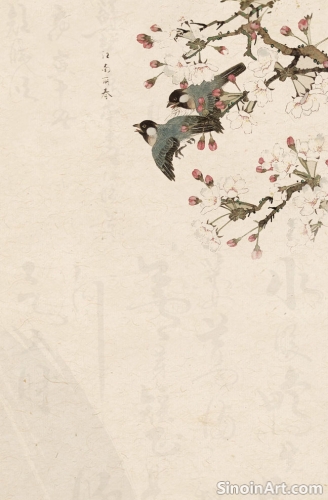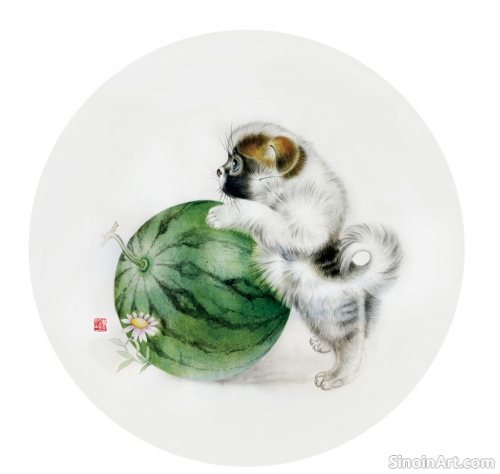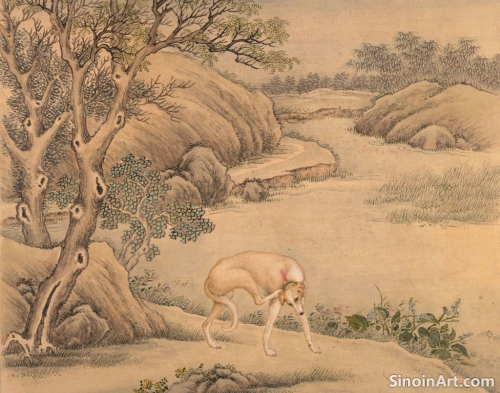The Use of White Space in Gongbi Composition
|
While often associated with meticulous detail, white space plays a critical role in the composition of Gongbi paintings. In Chinese art, white space is not seen as empty or blank; it is an active element of the artwork that contributes to the overall balance, harmony, and visual impact of the composition. White space creates a place for the eye to rest and allows the detailed work to be more appreciated.  The strategic use of white space in Gongbi painting helps to define and emphasize the main subject of the artwork. By surrounding detailed areas with blank space, the artist can draw the viewer's attention to the specific points of interest. This interplay between detail and open space guides the viewer's eye.  White space also contributes to the sense of depth and dimension in the painting. By creating a visual contrast between filled and empty areas, the artist can create a sense of space that gives depth to the painting. The use of negative space allows the viewer's eyes to interpret the space in a variety of ways.  In Gongbi painting, white space is not merely a background; it is a vital element that is just as important as the painted areas. The artist must carefully consider how the white space is distributed throughout the composition, making it an intentional choice. The artist carefully chooses where not to place detail in the painting to create a more powerful composition. The use of white space in Gongbi also reflects the Taoist philosophy of emptiness and balance. The interplay of filled and empty spaces represents the interplay of yin and yang, emphasizing the idea that emptiness is just as important as fullness. This philosophical element creates a work that is not just visually compelling, but also spiritually meaningful. By understanding the importance of white space in Gongbi painting, viewers can appreciate the artistry and depth of the composition. The strategic use of blank areas enhances both the detail of the painted parts as well as the overall impact of the work. The use of blank space adds a dimension to the work that makes it more compelling to the viewer. |
Tag : White space in art, Gongbi composition, negative space, art balance, visual design
Related information
- Brushstrokes of Precision: The Techniques of Gongbi
- The Materials of Gongbi: A Closer Look at Tools and Pigments
- Gongbi and the Court: Patronage and Artistic Standards in Imperial China
- Gongbi and the Depiction of Water: Flow, Reflection, and Atmosphere
- The Symbolism of Gongbi: Decoding the Language of the Brush
This article delves into the specific techniques of Gongbi painting, focusing on the outlining method, color application, detailed depiction, traditional materials, and the discipline required for mastery.
This article provides a detailed overview of the materials used in Gongbi painting, including rice paper, Chinese brushes, inksticks, and natural mineral pigments, emphasizing the importance of these traditional elements to the art form.
The history of Gongbi painting is intrinsically linked to the imperial courts of China, where it flourished under the patronage of emperors and the elite classes. The demand for highly detailed and realistic depictions of the natural world and court life led to the development of the meticulous techniques and refined aesthetic characteristic of the Gongbi tradition. This patronage significantly shaped the evolution and preservation of this distinctive style.
The depiction of water, with all its fluidity, dynamism, and reflective qualities, is a significant element in many Gongbi paintings. Artists employ a variety of techniques to capture the movement, texture, and atmospheric effects of water, ranging from still ponds and meandering streams to rushing waterfalls and expansive seas. The depiction of water is often a central element of a successful composition, adding depth and beauty to a piece.
This article explores the symbolic elements found in Gongbi paintings, focusing on the meanings behind flowers, animals, colors, and compositions within the Chinese artistic tradition.